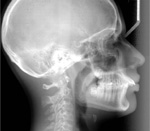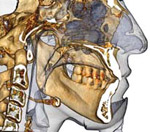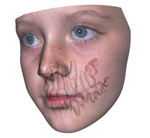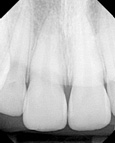Choose a glossary:
» Parts of Braces
» Orthodontic Procedures
Parts of Braces
Appliance: Anything Dr. Brodsky attaches to your teeth which moves your teeth or changes the shape of your jaw.
Archwire: The metal wire that acts as a track to guide your teeth along as they move. It is changed periodically throughout treatment as your teeth move to their new positions.
Band: A metal ring that is cemented to your tooth and fits completely around it. Bands are only used on your back teeth.
Bond: The seal created by orthodontic cement that holds your appliances in place.
Bracket: A metal or ceramic part cemented (“bonded”) to your tooth that holds your archwire in place.
Coil Spring: A spring that fits between your brackets and over your archwire to open space between your teeth.
Elastic (Rubber Band): A small rubber band that is hooked between different points on your appliances to provide pressure to move your teeth to their new position.
Elastic Tie: The rubber band that fits around your bracket to hold the archwire in place. They come in a variety of colors.
Headgear: Headgear uses an external wire apparatus known as a facebow to gently guide the growth of your face and jaw by moving your teeth into proper position. The force is applied to the facebow by a spring-loaded neck strap or head strap. The straps have a safety release that disconnects if the facebow is pulled or snagged.
Headgear Tube: A round, hollow attachment on your back bands that the inner bow of your headgear fits into.
Herbst® Appliance: The Herbst® appliance reduces overbite by encouraging the lower jaw forward and the upper molars backward. This fixed appliance is used mostly for younger, growing children and is worn for about twelve months.
Hook: A welded or removable arm to which elastics are attached.
Lip Bumper: A lip bumper is a thick wire attached to a molded piece of plastic. The lip bumper holds back the molars on your lower jaw to provide more space for your other teeth.
Mouthguard: A device that protects your mouth from injury when you participate in sports or rigorous activities.
Palatal Expander: A device that makes your upper jaw wider.
Retainer: An appliance that is worn after your braces are removed, the retainer attaches to your upper and/or lower teeth to hold them in place. Some retainers are removable and others are bonded to the tongue-side of several teeth.
Separator or Spacer: A little rubber ring that creates space between your teeth before the bands are attached.
Tie Wire: A fine wire that is twisted around your bracket to hold the archwire in place.
Wax: Wax is used to stop any part of your braces from irritating your lips or cheeks.
Orthodontic Procedures
Banding: The process of fitting and cementing orthodontic bands to your teeth.
Bonding: The process of attaching brackets to your teeth using special orthodontic cement.
 Cephalometric X-ray: A profile x-ray of your head which shows the relative positions and growth of the face, jaws, and teeth.
Cephalometric X-ray: A profile x-ray of your head which shows the relative positions and growth of the face, jaws, and teeth.
Consultation: A meeting with Dr. Brodsky and the treatment coordinator to discuss your dental concerns or treatment.
Debanding: The process of removing cemented orthodontic bands from your teeth.
Debonding: The process of removing cemented orthodontic brackets from your teeth.

 iCAT 3D Scan: A 3-D rendering of the head and neck area using cone-beam computer tomography which can be used to provide a more comprehensive orthodontic diagnosis than tradtitonal 2-D black and white X-rays.
iCAT 3D Scan: A 3-D rendering of the head and neck area using cone-beam computer tomography which can be used to provide a more comprehensive orthodontic diagnosis than tradtitonal 2-D black and white X-rays.
Impressions: The process of making a study model of your teeth by using a soft material that hardens into a mold of your teeth. Study moldels are used to help Dr. Brodsky prepare a diagnosis and treatment plan.
Ligation: The process of attaching an archwire to the brackets on your teeth.
 Panoramic X-ray: A black and white image produced by an x-ray machine that rotates around your head to take a picture of your teeth, jaw and other facial areas.
Panoramic X-ray: A black and white image produced by an x-ray machine that rotates around your head to take a picture of your teeth, jaw and other facial areas.
 Periapical X-ray: The x-ray produced by an x-ray machine that takes a picture of a specific
individual area of the mouth.
Periapical X-ray: The x-ray produced by an x-ray machine that takes a picture of a specific
individual area of the mouth.